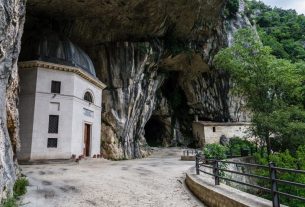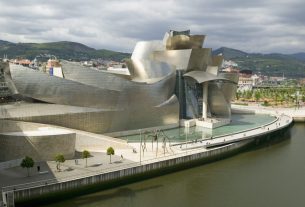In the middle of the Siberian taiga there has been a huge hole in the ground since the 1960s, which continues to grow. Locals reverently call it the “Gateway to the Underworld.” It is a sign of radical change taking place around the world and at the same time a source of valuable information for scientists.
The Verkhoyansky region of Siberia is an inhospitable place. In northeastern Russia, in the Republic of Sakha (Yakutia), it is cold most of the year. Freezing cold. From a climatic point of view, the Verkhoyansk region is even considered the “cold pole” of the Northern Hemisphere, in winter the temperature here drops to minus 68 degrees Celsius. The average maximum temperature in summer is 13.7 degrees Celsius. But as if this environment weren’t misanthropic enough, there’s another problem. In the center of the region, after the Batagai place, there is a giant hole in the middle of the earth – the Batagaika “crater”. It is at least 950 meters long and has an area of over 80 hectares, or about 112 football fields. Thanks to this frightening size, the crater is also called the “Gateway to the Underworld” by locals.
Indeed, from a purely scientific point of view, it is neither a ‘gate’ nor a ‘crater’, says Dr. Thomas Opel by Alfred Wegener Institute (AWI) in Potsdam, which he has already been there himself twice, in 2017 and 2019. He explains to TRAVELBOOK: “Scientifically defined, a crater only occurs after a volcanic eruption or a meteorite impact.” Correctly, it is a “dew slip on a slope”. In English, the location is referred to as a “megaslump,” which would be roughly translated as “mega-sag.” However, Opel admits that the giant hole in Batagaika looks similar to a crater, so such a designation is at least not completely absurd.
Whatever the name, the fact is that Batagaika “crater” has been growing since it formed in the 1960s, engulfing everything in its immediate vicinity. On average, it increases 10 to 30 meters per year. Opel estimates that the so-called “megaslump” grew by 50 meters between 2019 and 2021 alone. There is a simple scientific explanation for this.
How the Batagaika “crater” was formed

The reason for the constant growth of the Batagaika crater lies in the increasingly rapid thawing of the permafrost soils present in this area, exceptionally ancient and also particularly sensitive, such as Opel and a team of international researchers discovered in 2021. In fact, it was concluded that the deepest permafrost layers in the region are even around 650,000 years old. “We now know that the Batagaika permafrost survived natural warm periods in the geological past,” says Sebastian Wetterich, also of AWI, about the findings. Normally, as the name suggests, these soils, which are mostly water, are permanently frozen. However, more and more permafrost soils are currently thawing around the world. A consequence of global warming and “other human influences on the surface,” says Wetterich.
This is how the Batagaika “crater” was formed. In the area around the crater, trees were massively felled in the 1960s. As a result, the underlying ground, which was previously shaded by trees, was now exposed and unprotected from the sun’s rays. The permanently frozen ice melted and turned into water, the upper layers of the earth began to sink into the thawing and softer underground. Over the years, the now huge “crater” was formed. This process is called thermokarst.
At the moment it is not foreseeable that the “crater” will stop growing. Also because it’s getting hotter across the region. “Since the mid-20th century, the average annual temperature in Batagai has risen by around 2.4 degrees Celsius and the average summer air temperature by around 1.6 degrees Celsius,” writes Opel in a scientific article published in the spring of 2023.
catastrophic effects
Melting permafrost soils is not only problematic because gigantic depressions such as those in Batagai sometimes form. But also because permafrost normally binds pollutants in ice and soil. AWI scientists assume “that the frozen ground contains between 1,300 and 1,600 gigatons of carbon. For comparison: the entire atmosphere currently contains about 800 gigatons of carbon.
If permafrost soils now thaw, as they currently do in the Siberian taiga and numerous other places around the world, carbon is released in the form of carbon dioxide and other pollutants such as methane. Both carbon and methane carry according to the Federal Environment Agency through their share in the atmosphere, a very large part of the man-made greenhouse effect. The higher their concentration, the faster temperatures are likely to rise in the future, with the well-known consequences that climate change is having around the world.
Unique insights thanks to the Batagaika “crater”.
If you want to get something positive out of the ‘gateway to the underworld’, which is incidentally the largest and fastest growing ‘megaslump’ in the world, then researchers can gain a lot of knowledge from it. On the one hand, this applies to the ice itself, as Opel explains: “A whole range of geochemical studies can be carried out on the ice, which in turn allow us to draw conclusions about past climates.”
On the other hand, thawing permafrost soils repeatedly bring to light interesting remains. Tree stumps, plant remains and even animal carcasses have already been discovered. These provide information on the geological composition of the landscape in distant times.
In 2018, researchers even discovered a completely preserved Ice Age foal here. Researchers at Yakutsk University estimated the horse’s age at 30,000 to 40,000 years. The animal was perfectly preserved by the permafrost, even the fur was still intact. “Soft tissue such as stomach contents could also be examined – this is a very unique finding,” says Opel.

Will there be more “craters” in the future?
Indeed, there may be other equally fascinating discoveries in the future. As the crater continues to expand, scientists expect the megaslump to release more fossil organic matter. It is also assumed that this “crater” will not remain in the region. “There is the potential for many such collapses to emerge, although probably not to this extent,” says Opel. “That’s because the permafrost here is very frozen, up to 80%. When the ice melts, we have a lot of water running off and the ground subsides.”
For more ‘craters’ to form, however, the vegetation would have to be disturbed, as was the case with the Batagai ‘crater’. Because, as already mentioned, clearing trees leads to much faster thawing. If the deforestation is deliberate, as in the case of the Batagaika ‘crater’, this process must be stopped. But there are other factors as well: “Fire is also a factor. In these permafrost regions, such as Siberia or Canada, we are currently experiencing forest fires that are so massive that the vegetation cover is disturbed to such an extent that even the permafrost is starting to break down,” explains Opel.
Also interesting: What to do if there is a fire in my holiday region?
Moreover, according to the scientist, it is foreseeable that the Batagaika “crater” will grow so much in the future that it will connect with the adjacent valley in the coming years. This could in turn affect its growth dynamics – in which direction, i.e. higher or lower, is not yet clear. “There could be a big crack and the next valley just becomes part of the megaslump, but it could also be that the meltwater flows out through the new valley.” As with the “crater”, which is actually not at all, it continues, so it remains exciting.




